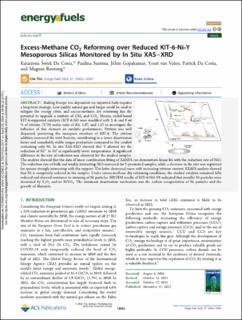| dc.contributor.author | Świrk Da Costa, Katarzyna | |
| dc.contributor.author | Summa, Paulina | |
| dc.contributor.author | Gopakumar, Jithin | |
| dc.contributor.author | van Valen, Youri | |
| dc.contributor.author | Da Costa, Patrick | |
| dc.contributor.author | Rønning, Magnus | |
| dc.date.accessioned | 2024-04-23T09:07:50Z | |
| dc.date.available | 2024-04-23T09:07:50Z | |
| dc.date.created | 2023-12-05T10:03:41Z | |
| dc.date.issued | 2023 | |
| dc.identifier.issn | 0887-0624 | |
| dc.identifier.uri | https://hdl.handle.net/11250/3127743 | |
| dc.description.abstract | Making Europe less dependent on imported fuels requires a long-term strategy. Low-quality natural gas and biogas could be used to mitigate the energy crisis, and excess-methane dry reforming has the potential to upgrade a mixture of CH4 and CO2. Herein, nickel-based KIT-6-supported catalysts (KIT-6-Ni) were modified with 3, 6, and 8 wt % of yttrium (Y/Ni molar ratio of 0.5, 1.07, and 1.5) to investigate the influence of this element on catalytic performance. Yttrium was well dispersed, preserving the mesopore structure of KIT-6. The yttrium addition increased the total basicity, contributing to a lower deactivation factor and remarkably stable syngas production compared to the catalyst containing only Ni. In situ XAS-XRD showed that Y allowed for the reduction of Ni2+ to Ni0 at significantly lower temperatures. A significant difference in the rate of reduction was observed for the studied samples. The analysis showed that the data of linear combination fitting of XANES can demonstrate linear fits with the reduction rate of NiO. The reduction rate of bulk and weakly interacting NiO increased for Y-promoted samples, while a decrease in the rate was registered for species strongly interacting with the support. The latter decreased more with increasing yttrium content. EXAFS analysis showed that Ni is completely reduced in the samples. Under excess-methane dry reforming conditions, the studied catalysts remained fully reduced and showed resistance to sintering of Ni particles. HRTEM results of KIT-6-Ni5-Y8 indicated that metallic Ni particles were decorated by Y2O3 and/or NiYO3. The dominant deactivation mechanism was the carbon encapsulation of Ni particles and the growth of filaments. | en_US |
| dc.language.iso | eng | en_US |
| dc.publisher | ACS Publications | en_US |
| dc.rights | Navngivelse 4.0 Internasjonal | * |
| dc.rights.uri | http://creativecommons.org/licenses/by/4.0/deed.no | * |
| dc.title | Excess-Methane CO2 Reforming over Reduced KIT-6-Ni-Y Mesoporous Silicas Monitored by In Situ XAS–XRD | en_US |
| dc.title.alternative | Excess-Methane CO2 Reforming over Reduced KIT-6-Ni-Y Mesoporous Silicas Monitored by In Situ XAS–XRD | en_US |
| dc.type | Journal article | en_US |
| dc.type | Peer reviewed | en_US |
| dc.description.version | publishedVersion | en_US |
| dc.source.pagenumber | 18952–18967 | en_US |
| dc.source.volume | 37 | en_US |
| dc.source.journal | Energy & Fuels | en_US |
| dc.source.issue | 23 | en_US |
| dc.identifier.doi | 10.1021/acs.energyfuels.3c02994 | |
| dc.identifier.cristin | 2208954 | |
| cristin.ispublished | true | |
| cristin.fulltext | postprint | |
| cristin.fulltext | postprint | |
| cristin.qualitycode | 2 | |

